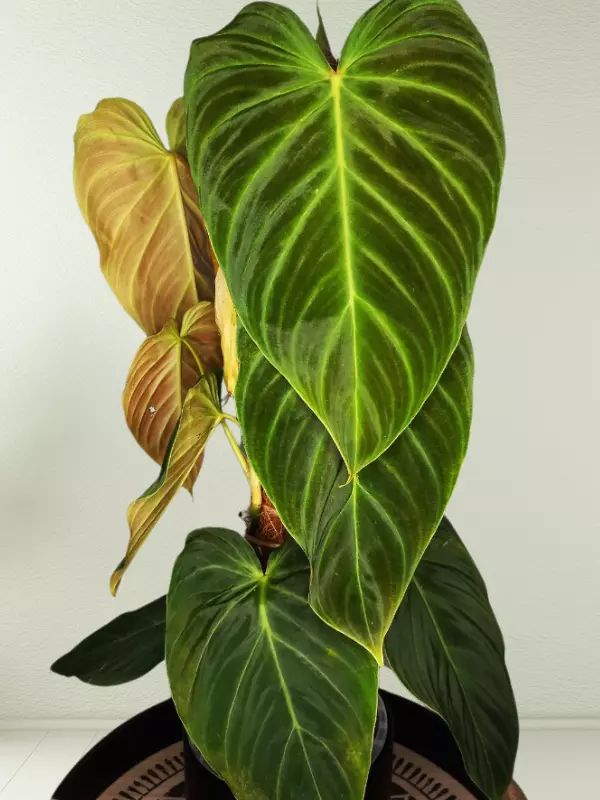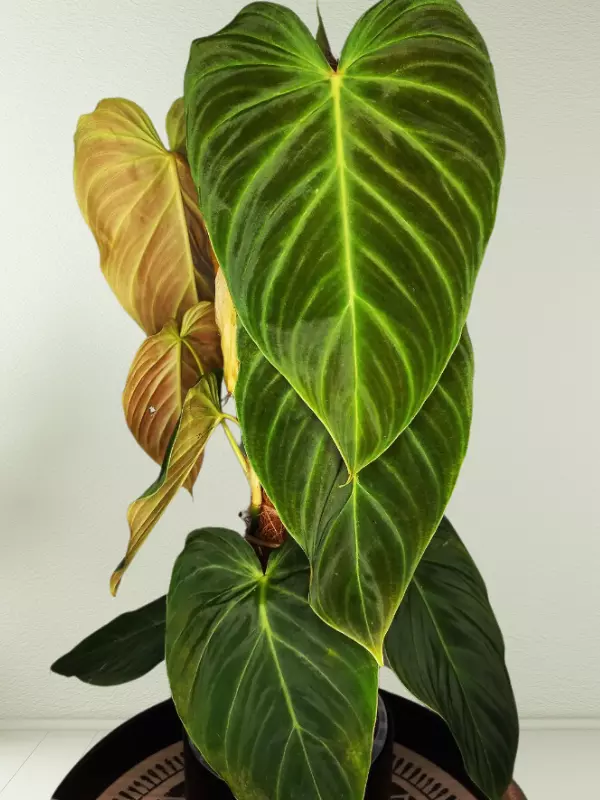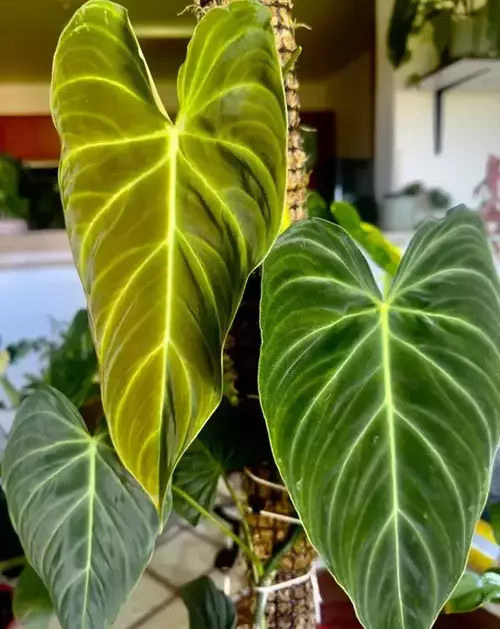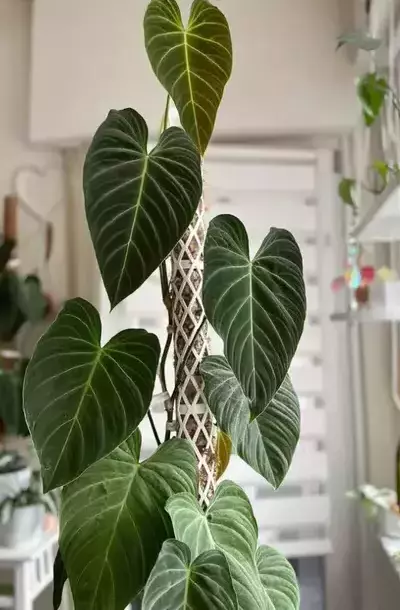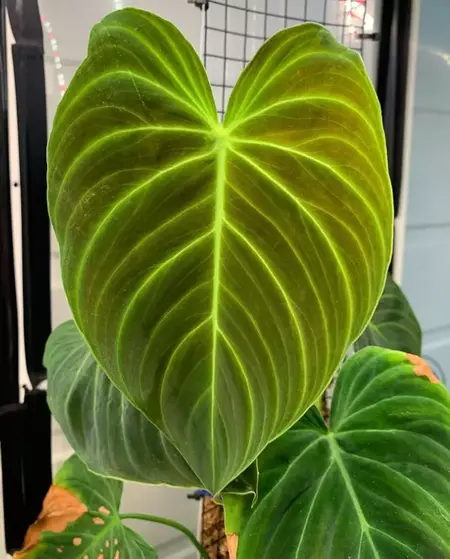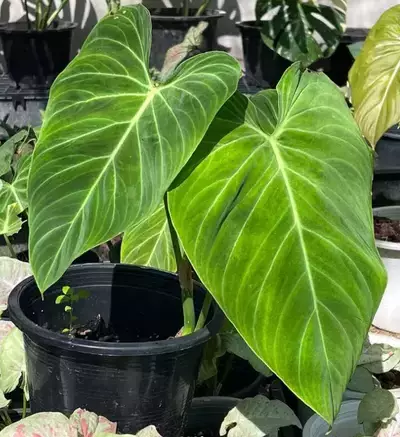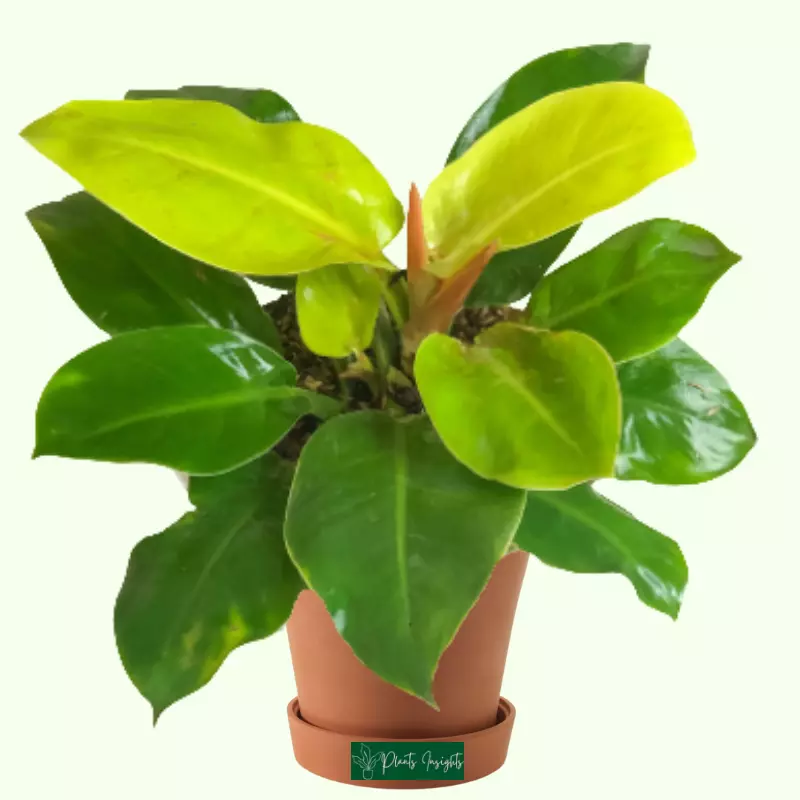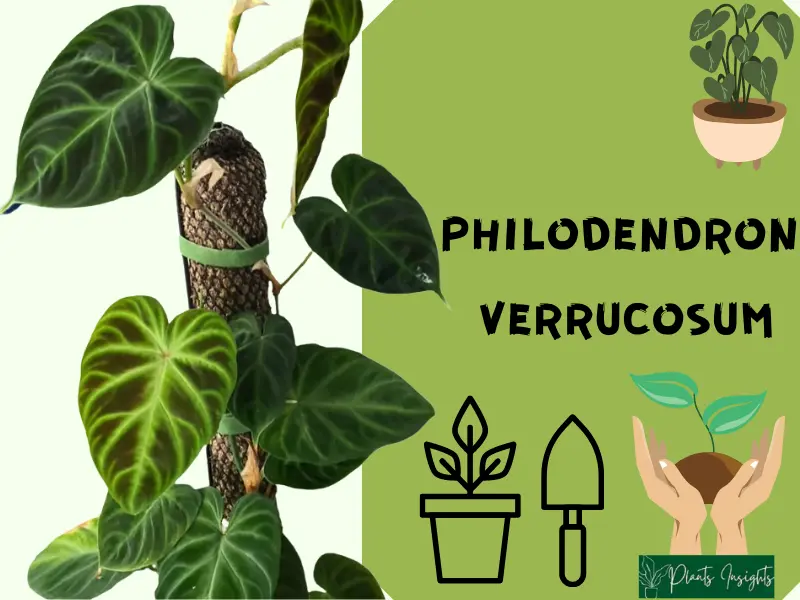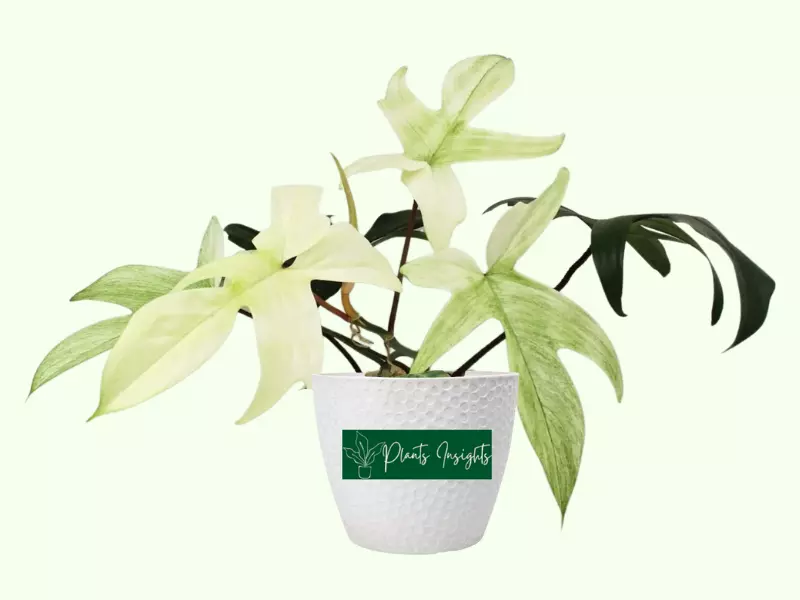In the vast dominion of nature’s vegetal treasures, there exists a plant that effortlessly captivates with its inviting appeal and enchanting foliage- the Philodendron Splendid. This botanical masterpiece manifests unparalleled beauty through its exceptional features. Philodendron ‘Splendid’ (Verrucosum x Melanochrysum) is a stunning hybrid of two spectacular species of the Araceae family: Philodendron Melanochrysum Linden & André and Philodendron Verrucosum L.Mathieu ex Schott.
As the name suggests, the Philodendron Splendid is an exquisite botanical marvel renowned for its captivating allure and enthralling characteristics. This gem showcases resplendent foliage, boasting an array of lush, glossy leaves adorned with mesmerizing patterns of intricate veins. It features an exquisite combination of vibrant green hues, delicate variegation, and an elegant growth pattern, creating a striking visual spectacle, elevating any space.
Closely-Related Allied Species: Philodendron Verrucosum, Philodendron Mamei, Philodendron Moonlight, Philodendron Squamiferum, Philodendron Florida Ghost, Philodendron Moonlight, Philodendron Ring of Fire
Essential Products
Origin and Family
| Botanical Name | Philodendron Melanochrysum x Verrucosum |
| Family Name | Araceae |
| Other names | Philodendron Splendid |
| Plant Type | Perennial |
| Origin | Hybrid of Melanochrysum x Verrucosum |
| Color | Velvety dark green leaves |
| Leaf Shape | Elongated heart-shaped |
| Height | 6 to 8 feet tall |
| Humidity | 60% or more |
| Temperature | 65°F to 85°F (18°C to 29°C) |
| Light Need | Bright indirect light |
| Propagation | Stem cutting , Air layering |
| Soil type | Well-drained, rich in organic matter aroid mix |
| Preferred PH | Moderate to Slightly acidic (5.6 to 6.5) |
| Toxicity | Toxic to humans and pets |
| Repotting | Once a year |
What is Philodendron Splendid?
Philodendron Verrucosum x Melanochrysum is a climbing hybrid of Philodendron Melanochrysum and Philodendron Verrucosum, inheriting the best traits from both parents. Both parents are native to the rainforests of Ecuador, where they grow as hemiepiphytic under tree canopy; hence the Philodendron Splendid loves the tropical environment and is adaptive to low light conditions. Whenever we have a hybrid, one of the parentage can be more dominant, so not all Splendid Philodendrons of this world might look the same.
Philodendron Splendid is a herbaceous vine featuring big, velvety, heart-shaped leaves with appealing prominent veins that will climb, given proper support. In addition, Splendid’s petioles are terete growing conspicuously velutinous cordate leaf blades exhibiting dark green and slightly tinged red undersides (Verrucosum parentage). The beautiful red backs cause the front of the leaves to have these really intense veining, almost like lime green lining, and the sinus is also a little bit red.
Is Philodendron Splendid a climber or crawler?
Philodendron Splendid is also a climber due to its parentage, and the elongated velvety heart-shaped leaves can grow to an impressive size if you give it the support of a moss pole to climb on.
Splendid Philodendrons can grow four to six feet tall, occupying a more significant amount of your space because of their large leaf size. You can also mount your plant on janky support sticks, but the chances are it will produce smaller leaves than it would produce if mounted on a moss pole.
Does Philodendron Splendid grow fast?
Philodendron Splendid has a moderately fast growth rate primarily when provided with bright indirect light, warm temperature, and a moss pole support. With the potential to reach up to 6 feet in height, its substantial foliage adds a striking element to its overall allure. Therefore please ensure you have plenty of space if you plan on getting one.
How do you care for a Philodendron Splendid?
Caring for the Philodendron Splendid entails a meticulous approach, where attention to detail and a profound understanding of its unique needs are paramount. To ensure its thriving beauty, one must provide dappled shade, well-draining soil, and balanced hydration.
A habitat with temperatures between 65°F and 80°F and humidity levels around 60% will mimic its tropical origins.
Regular fertilization with a water-soluble, nutrient-rich formula stimulates growth while grooming and support for its vines to maintain their enchanting magnetism.
With this care, the Philodendron Splendid unveils its verdant magnificence. Let’s delve into the care details of this alluring plant.

Bringing the P. Splendid to home
The new plant you bring home can be a carrier of pests and diseases. It is essential to quarantine your new plant for two weeks before introducing it to other indoor plants to protect them from contamination. In case your new plant is pest infested, there are great chances that your other plants will be infected if they come in contact. Especially spider mites and Meally bugs infestation spreads really quickly among the plants and becomes a bit of a challenge to control.
Carefully inspect the whole plant, especially the leaves, as pests feed on the leaves lower sides. Moreover, it is always a great practice to shower your plant when bringing it home to eliminate dust and any potential pests. For precautionary measures, apply neem oil or spray the pesticide on the leaf surface if you notice any pest invasion.
My routine is to spray my new plants with Instant Plant Protection tablets before putting it with other plants and it has saved me the trouble of having pest infestation many times over the years.
After two weeks, if the plant doesn’t show any pests and disease symptoms, place it in a bright, humid area among other plants to thrive happily indoors.

Watering
Understanding the watering requirements of the Philodendron Splendid is crucial for fostering its thriving growth and safeguarding its radiant beauty. Let’s explore its watering needs during the scorching heat of summer and the dormant chill of winter.
During the summer months, this plant yearns for water. As a general guideline, watering the plant thoroughly once a week is recommended, allowing the soil to dry slightly between waterings. This routine ensures the roots receive adequate moisture without being submerged in a perpetually soggy environment, which could lead to root rot and other detrimental consequences.
As the winter arises, this philodendron enters a period of dormancy, where its growth slows, and its water requirements diminish. During this time, it is essential to adjust the watering frequency accordingly. Instead of a weekly routine, watering every 10 to 14 days or when the top inch of soil feels dry is advised. This measured approach prevents overhydration, enabling the plant to conserve energy and thrive within the natural rhythms of the season.
Effects of Overwatering
Overwatering poses a significant threat to the Philodendron Splendid. Excessive moisture suffocates the roots, depriving them of essential oxygen and impeding their ability to absorb nutrients. The overwatering results in wilted, yellowing leaves and a foul odor from the soil. When these symptoms arise, it is crucial to adjust the watering regimen promptly, allowing the soil to dry out before resuming a more balanced routine.
Effects of Underwatering
On the other hand, underwatering can present challenges for the lovely Splendid. Insufficient moisture deprives the plant of its life force, leading to stunted growth and lackluster foliage. Signs of underwatering include drooping leaves, browning leaf tips, and a generally withered appearance. If these symptoms arise, adjusting the watering schedule by increasing the frequency can help rejuvenate the plant and restore its vitality.


Light
Philodendron Splendid can grow in environments with dappled or filtered sunlight rather than intense, direct rays. This botanical gem flourishes when provided with bright, indirect light, mimicking its parents’ natural habitat’s gentle glow. Placing it in a location that receives moderate to bright, indirect light will satisfy its light-loving tendencies, allowing it to bask in the luminous embrace it craves.
For indoor placement, this lovely hybrid seeks spaces that offer an abundance of filtered light. Positioning it near a north or east-facing window is ideal, as it allows the plant to receive gentle morning or late afternoon sunlight. This positioning ensures a balanced dose of light and creates an ambiance of natural beauty.
It is essential to shield its velvety leaves from direct sunlight. Prolonged exposure to intense rays can scorch its delicate foliage, causing unsightly burns and irreversible damage. The leaves may display brown patches or develop a bleached appearance, signaling that the plant receives more light than it can bear.
Additionally, wilting, curling, or drying of leaves can occur due to excessive light, causing stress to the plant. These signs serve as a warning call to reevaluate the light conditions and adjust accordingly. Therefore, it is essential to find a balance between providing ample brightness and sheltering the plant from the harshness of direct sunbeams.
Conversely, lacking light can hinder the plant’s growth potential and compromise its visual allure. Insufficient light may lead to leggy, elongated stems as the plant stretches toward the nearest light source to satisfy its desire for brightness. The leaves may lose their luster, becoming smaller in size. These symptoms indicate that relocating the plant to a spot with greater light accessibility or providing supplemental artificial lighting can help restore its vigor and beauty.

Humidity
As the Philodendron’s Splendid parentage hails from tropical regions, it longs for a humidity-rich environment to thrive. Ideally, a humidity level of around 60% replicates its natural habitat and is ideal for optimal growth. Adequate humidity ensures the plant’s foliage remains supple and lush, aiding transpiration and nutrient absorption. A balanced humidity level also promotes healthy growth, discourages pest infestations, and prevents leaf dryness or browning.
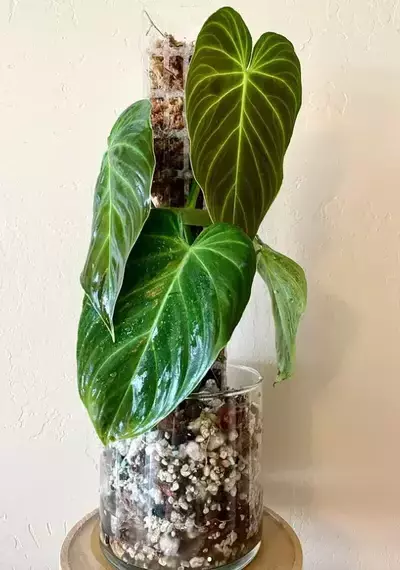
As Philodendron Splendid has velvety leaves, insufficient humidity can be challenging for this plant, resulting in visible symptoms of dry, crispy leaf edges, browning tips, and drooping foliage. To avoid this situation, various methods can be employed to elevate humidity levels around the plant, such as utilizing a plant humidifier, placing a tray of water nearby, keeping your plant in high-humidity places such as the bathroom or kitchen, or grouping indoor plants to create a microclimate of increased moisture.
However you might hear about misting your plant to increase the humidity, but in my experience, it’s not practical. Let’s face it, firstly, misting your plant will increase the humidity temporarily, and 2ndly it’s a hectic job to mist a large group of plants frequently. I would highly suggest investing in a good plant humidifier if you own some tropical plants.
Temperature
Regarding temperature, the Philodendron Splendid thrives within an ideal range of approximately 65°F to 80°F. This moderate temperature spectrum gives the plant optimal conditions for growth, development, and photosynthesis.
Lower temperatures can adversely affect the plant, impeding its growth and leading to various symptoms of distress. Exposure to chilly conditions below 55°F can result in stunted growth, yellowing leaves, and increased disease vulnerability. Frost or freezing temperatures pose an immediate threat, causing irreversible damage to the plant’s delicate tissues. Shielding the plant from drafts and providing ample warmth during colder months safeguards its well-being.
Equally, high temperatures can trigger a force of negative consequences. Extended exposure to intense heat, surpassing 90°F, may lead to leaf scorching, wilting, or discoloration. The plant’s photosynthetic process can become disrupted, inhibiting nutrient absorption and overall growth. Providing shade, proper ventilation, and strategic positioning away from heat sources can mitigate the adverse effects of excessive heat.
Sudden temperature variations can stress this Philodendron, challenging its overall health. Swift shifts from warm to cold or vice versa can cause shock, leading to leaf drop, wilting, or even plant death. Therefore, gradual adjustment to changing temperatures, avoiding abrupt transitions, and shielding the plant from extreme fluctuations are crucial to maintaining its balance.

Potting Soil
The soil in which the Philodendron Splendid is planted plays a vital role in its overall health and vitality. Providing the plant with a well-suited soil mix ensures the optimal balance of nutrients, moisture retention, and drainage capacity.
The Philodendron Splendid’s soil mix should have specific properties to support its growth and development. Using a nutrient-rich, well-draining soil mix that retains moisture without becoming excessively soggy is recommended.
A blend that consists of organic matter, such as 30% potting soil, 20% perlite, 10% activated charcoal, 10% worm casting, 10% coco peat, and 20% orchid bark, promotes a balanced soil structure, allowing for adequate airflow and root respiration.
The optimum pH level for this plant falls within the slightly acidic to neutral range, typically around 5.5 to 7.0. Ensuring the soil’s pH level is within this range enables the Splendid to thrive and flourish.
Choosing a well-drained potting soil helps Philodendron Splendid’s roots have oxygen flow and thrive. A balanced blend that provides proper moisture retention, drainage, and nutrient availability ensures the plant’s roots can establish a solid foundation for growth.
Besides that, you can also choose from our recommended potting mixes available in the market, such as:

Repotting
The Philodendron Splendid, may require occasional repotting to ensure its continued growth. Repotting becomes necessary when the plant outgrows its current container, exhibiting signs such as root congestion, limited soil volume, or stunted growth.
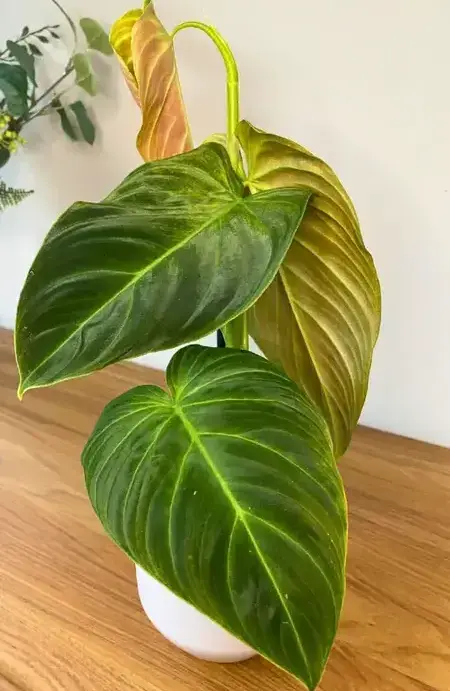
Typically, repotting is recommended every 1 to 2 years, preferably during the spring season when the plant enters its active growth phase. This timing allows the plant to recover quickly and establish itself in its new pot.
To embark on the repotting journey, gather the necessary tools and materials: a slightly larger pot with drainage holes, fresh potting soil, a gardening tool, and protective gloves if desired.
Follow these step-by-step instructions for a successful repotting experience:
Prepare the new pot
Select a pot one size larger than the current container, ensuring it has adequate drainage holes to prevent waterlogging. Thoroughly clean the pot to remove any residue from previous use.
Prepare the plant
Water the Philodendron Splendid a day or two before repotting. This helps hydrate the plant and loosen the roots, making removing it from its current pot easier.
Gently remove the plant
Carefully tilt the current pot and gently tap the sides to loosen the root ball. Then slide the plant out of the pot. If the roots are tightly bound, use a tool to loosen them slightly without causing excessive root damage.
Inspect the roots
Examine the root system for any dead, diseased, or overly long roots. Trim away any damaged or unhealthy roots using clean, sterilized pruning shears.
Add fresh potting soil
Place a layer of fresh and new potting soil in the bottom of the new pot. The soil should be well-draining and nutrient-rich, providing a suitable medium for the Philodendron Splendid to thrive. Ensure the pot is filled enough to allow the plant to sit at the same depth as it was in the previous pot.
Reposition the plant
Gently position the plant in the center of the new pot, ensuring the plant sits upright. Adjust the soil level if necessary to maintain the appropriate planting depth.
Fill the remaining space
Carefully fill the gaps around the plant with additional potting soil, gently pressing it down to eliminate air pockets.
Water and settle the plant
Thoroughly water the plant after repotting to help settle the soil and initiate root establishment. Allow any excess water to drain out and ensure that the plant is not sitting in standing water.

Philodendron Splendid Propagation
Philodendron Splendid can easily be propagated via stem cuttings and air layering with 99% success rate.
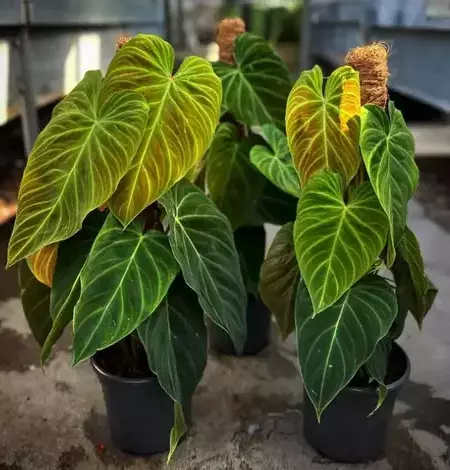
Stem Cutting Propagation
I prefer stem-cutting propagation for this climbing philodendron as this is simple and has a high success rate. As the leaves are enormous, single-node cuts are just fine for propagation.
Follow a step-by-step guide for Philodendrons Splendid propagation via stem cutting.
Propagation in Water
You can put your Philodendron Splendid cutting in water to propagate if it has minimal aerial roots. However the cutting takes relatively long time to root in water.
Propagation in Sphagnum Moss and Potting soil
You can also use sphagnum moss and aroid potting mix for rooting your cuttings. I prefer using sphagnum moss for cuttings that have a little bit of roots and potting mix directly if they already have a lot of roots.

Before putting your cuttings in sphagnum moss or potting mix, you might need to seal the edge of your cutting by applying cinnamon powder, anti-fungal powder, or activated charcoal to prevent rotting.
Choose a small plastic pot, put the Splendid’s cutting in it, and cover the node with a little potting mix. You don’t want to bury the node too much in the potting mix as it will increase the incidence of over-watering.
Air Layering Propagation
Philodendron Splendid grows aerial roots along its stem and can be propagated using air layering method. However, this is less common method but possible if you don’t want to cut your plant.

Fertilizing
Like many plants, the Philodendron Splendid benefits from periodic fertilization to sustain its growth and vitality. Understanding when and how to fertilize this remarkable plant is the key to providing it with the necessary nutrients for optimal development.
While the plant can survive without regular fertilization, applying a suitable fertilizer helps promote robust growth, vibrant foliage, and overall health.
Please opt for a balanced, water-soluble fertilizer with a ratio of equal or slightly higher nitrogen (N), phosphorus (P), and potassium (K), such as a 20-20-20 or 10-10-10 formulation. This balanced blend ensures the plant receives a diverse array of essential nutrients.
If you are new to plant parenting I highly recommend trying Miracle-Grow Indoor Plant Food Spikes. These pellets are really easy to use and will not burn any foliage of your plant.
Here are some good fertilizers for your Philodendron available on the market:
- Philodendron Plant Food, Indoor Plant Food Liquid Fertilizer
- Liqui-Dirt Nano Powder All-Purpose Organic Plant Food
- Osmocote Smart-Release Plant Food
The best time to fertilize the plant is during the active growing season, which typically spans spring to early fall. This period coincides with the plant’s natural growth cycle, allowing it to utilize the nutrients provided by the fertilizer efficiently. It is advisable to avoid fertilizing during the dormant period, which typically occurs during the winter months.
Frequency
Regarding frequency, fertilizing every 2 to 4 weeks is generally recommended during the active growing season. This interval allows for a steady supply of nutrients without overwhelming the plant’s root system. However, it is crucial to carefully observe the plant’s response and adjust the frequency as needed.
Over-fertilization can have adverse effects, leading to a build-up of salts in the soil and causing fertilizer burn. Similarly, under-fertilization, on the other hand, can result in nutrient deficiencies and slow growth. The plant may display pale, yellowing leaves, and its overall vigor may diminish. Finding the right balance and providing the Philodendron with the nutrients necessary to support its optimal health is essential.
Finally, it’s important to read and follow the instructions on the fertilizer package carefully. Different fertilizers have different instructions, so use the correct amount and feed your plant the right amount at the right frequency.

Pruning and Maintenance
The Philodendron Splendid boasts moderate maintenance, making it an accessible choice for both seasoned plant enthusiasts and beginners. Though not excessively demanding, it thrives with consistent care and periodic maintenance.
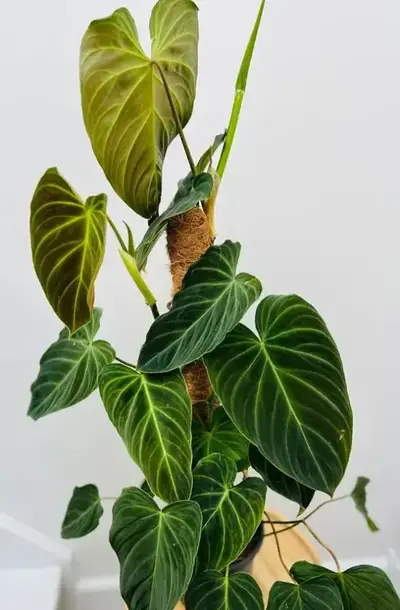
Pruning plays a pivotal role in the maintenance of this philodendron. This process involves removing dead or damaged leaves, stems, and unwanted growth. Pruning serves multiple purposes, including enhancing the plant’s appearance, encouraging new growth, and eliminating potential disease or pest issues. When embarking on pruning, using clean, sterilized tools help prevent the spread of pathogens, ensuring a healthy outcome for the plant.
During maintenance, it is beneficial to check the plant for any signs and symptoms of pests, diseases, or nutrient deficiencies. Vigilance allows for early detection and prompt intervention, safeguarding the plant’s well-being. Regularly checking the leaves, stems, and soil for irregularities ensures swift action, preventing potential issues from escalating and preserving the plant’s radiant vitality.
As a vining plant, the Philodendron Splendid may require occasional support and training to maintain its desired shape and prevent unruly growth. Gentle guiding of the vines along a trellis or support structure encourages a more orderly growth pattern. This practice enhances the plant’s visual appeal, promotes better airflow, and reduces the risk of entanglement or damage.

Toxicity
While the Philodendron Splendid enthralls with its captivating beauty, it is essential to be aware of its potential toxicity to humans and pets. With its lush foliage and vibrant presence, this remarkable plant contains certain compounds that can pose a risk if ingested or touched.
The Philodendron Splendid contains calcium oxalate crystals which are toxic to pets and humans. These crystals are found in the plant’s leaves, stems, and sap. When ingested or even when the sap comes into contact with the skin, it can cause varying degrees of irritation and discomfort.
For humans, if the leaves or sap of the Philodendron Splendid are ingested, it can result in symptoms such as oral irritation, burning sensation in the mouth, throat, and lips, difficulty swallowing, and stomach discomfort. It is crucial to seek medical help immediately if ingestion occurs or if severe symptoms develop.
Pets, such as dogs and cats, are also susceptible to the toxicity of the Splendid. Ingestion of the plant can cause similar symptoms of oral irritation, excessive drooling, difficulty swallowing, vomiting, and gastrointestinal upset. In some cases, pets may display signs of discomfort or pawing at the mouth. If your pet shows any of these symptoms, consult a veterinarian promptly for appropriate guidance and treatment.
To ensure the safety of both humans and pets, keeping the Philodendron Splendid out of reach is advisable. Place it in areas where curious hands and paws cannot access it readily, especially if you have young children or pets known for their exploratory nature. Educating family members and visitors about the potential toxicity of the plant can also help prevent accidental ingestion or contact

Diseases & Pests
The Philodendron Splendid, with its captivating presence, is not immune to the challenges posed by diseases, pests, and other common problems. Let us delve into these challenges and explore strategies for countering them effectively.
Diseases
The Philodendron Splendid may encounter certain diseases, primarily fungal, which can hinder its growth and vitality. Some common diseases include:
Leaf Spot
Fungal leaf spot diseases manifest as brown or black spots on the leaves. To manage them, remove and destroy affected leaves, ensure proper air circulation, and avoid overhead watering.
Root Rot
Excessive moisture and poor drainage can lead to root rot, characterized by dark, mushy roots. Adjusting watering practices, improving soil drainage, and using sterile soil can help prevent and treat root rot.
Bacterial Blight
This disease causes brown, water-soaked spots on the leaves, often accompanied by wilting. Prune and dispose of affected plant parts, and use copper-based fungicides as a preventive measure.
Pests
The Philodendron Splendid can fall victim to several common pests, including:
Mealybugs
These small, cotton-like insects often gather in clusters on the leaves, stems, and axils. To counter them, wipe the affected areas with a cotton swab dipped in rubbing alcohol or use organic insecticidal soap.
Spider Mites
These tiny arachnids may appear as specks and create fine webbing on the plant. Regularly misting the foliage, ensuring adequate humidity, and using insecticidal soap can help control spider mites.
Scale Insects
Scale insects appear as small, round bumps on the stems and leaves. They can be challenging to eliminate, but scrubbing them gently with a soft brush or using a horticultural oil spray can provide some control.
Common Problems
Apart from pests and diseases, the Philodendron Splendid can encounter additional challenges.
Overwatering
Excessive watering can lead to root rot and other moisture-related issues. Ensure proper drainage, allow the soil to dry slightly between waterings, and adjust the watering frequency according to environmental conditions.
Insufficient Light
Inadequate light can result in leggy growth and reduced liveliness. Place the plant in a location with bright, indirect light to promote healthy foliage development.
Crispy leaf tips:
One issue you might face with your Philodendron Splendid is the tips and edges of the leaves turning crispy, which could be due to low humidity or fungal infections. To prevent this, keeping your plant adequately hydrated is essential, but avoid over-watering it.
Maintaining moderate humidity levels can create the ideal growing conditions for a healthy and vibrant Splendid plant.

Common Queries
Is Philodendron Splendid rare?
The Philodendron Splendid is easily distinguished by its large, velvety leaves and impressive stature, making it a standout even when cultivated indoors. This plant holds a special place in the hearts of plant enthusiasts, commanding attention and often boasting a higher price due to its rarity.
What is the difference between Philodendron’s Glorious and Splendid?
When comparing the Philodendron Glorious and Splendid, two stunning plant varieties, it becomes evident that they possess distinct characteristics. While both plants exude beauty, they differ significantly. The Philodendron Glorious showcases a more compact nature, characterized by a shorter stem and smaller leaves. Additionally, its growth habit tends to be more upright. On the other hand, the Philodendron Splendid displays a sprawling growth pattern, and its larger leaves and elongated stem contribute to its captivating appeal.
Does Philodendron Splendid need a moss pole?
As Philodendron Splendid grows and matures, it tends to grow like a vine and gets assistance from having a support structure such as a janky sticks or moss pole on which to climb. By providing a sturdy support, you can also help to prevent plant’s stems and leaves from becoming tangled or damaged. Moreover, using moss pole will help your Splendid grow bigger leaves.

Conclusion
The Philodendron Splendid is a remarkable testament to nature’s artistry. With its lush foliage, graceful vines, and captivating beauty, this plant adds a touch of elegance and sophistication to any space.
Its adaptability, air-purifying qualities, and transformative presence make it a precious addition to any home or office. Embrace the splendor of the Philodendron Splendid and let it inspire a deeper connection to the wonders of the natural world, as it brings life, vibrancy, and a sense of tranquility to your surroundings.
Whether you are a seasoned horticulturalists seeking to expand your collection or a nature enthusiast longing for exquisite elegance, this Splendid Philodendron awaits.
Related Posts
Best Fan for Grow Tent | Clip On, Inline & Oscillating
Grow tent fans are specially designed to increase air circulation and ventilation. If you want to regulate the environment of your indoor growing space effectively, you need best grow tent fans .
Philodendron Moonlight Care & Growing Guide
The Moonlight Philodendron is a hybrid variety of the Philodendron genus from the Araceae family grown for its vivid foliage.
Philodendron Verrucosum (Ecuador Philodendron) Care
The Philodendron Verrucosum is a show stealer and one of the most stylish of all Philodendrons. The Philodendron Verrucosum is a flowering hemiepiphytic climber of the Araceae family.
Alocasia Sarian | Elephant Ear Plant Care
Alocasia Sariana (Elephant ear) is hybrid of the Zebrina and Micholitziana Alocasias featuring ginormous deep green pointed leaves.
Philodendron Florida Ghost or Florida Mint
The Philodendron Florida Ghost also known as Philodendron Pedatum is an affordable “rare” Philodendron that is easily attainable.

